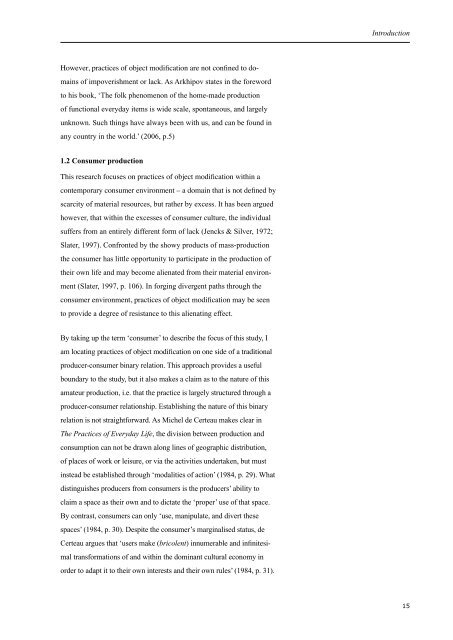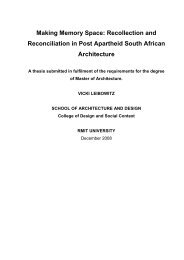Objects in Flux - RMIT Research Repository - RMIT University
Objects in Flux - RMIT Research Repository - RMIT University
Objects in Flux - RMIT Research Repository - RMIT University
You also want an ePaper? Increase the reach of your titles
YUMPU automatically turns print PDFs into web optimized ePapers that Google loves.
However, practices of object modification are not conf<strong>in</strong>ed to do-<br />
ma<strong>in</strong>s of impoverishment or lack. As Arkhipov states <strong>in</strong> the foreword<br />
to his book, ‘The folk phenomenon of the home-made production<br />
of functional everyday items is wide scale, spontaneous, and largely<br />
unknown. Such th<strong>in</strong>gs have always been with us, and can be found <strong>in</strong><br />
any country <strong>in</strong> the world.’ (2006, p.5)<br />
1.2 Consumer production<br />
This research focuses on practices of object modification with<strong>in</strong> a<br />
contemporary consumer environment – a doma<strong>in</strong> that is not def<strong>in</strong>ed by<br />
scarcity of material resources, but rather by excess. It has been argued<br />
however, that with<strong>in</strong> the excesses of consumer culture, the <strong>in</strong>dividual<br />
suffers from an entirely different form of lack (Jencks & Silver, 1972;<br />
Slater, 1997). Confronted by the showy products of mass-production<br />
the consumer has little opportunity to participate <strong>in</strong> the production of<br />
their own life and may become alienated from their material environment<br />
(Slater, 1997, p. 106). In forg<strong>in</strong>g divergent paths through the<br />
consumer environment, practices of object modification may be seen<br />
to provide a degree of resistance to this alienat<strong>in</strong>g effect.<br />
By tak<strong>in</strong>g up the term ‘consumer’ to describe the focus of this study, I<br />
am locat<strong>in</strong>g practices of object modification on one side of a traditional<br />
producer-consumer b<strong>in</strong>ary relation. This approach provides a useful<br />
boundary to the study, but it also makes a claim as to the nature of this<br />
amateur production, i.e. that the practice is largely structured through a<br />
producer-consumer relationship. Establish<strong>in</strong>g the nature of this b<strong>in</strong>ary<br />
relation is not straightforward. As Michel de Certeau makes clear <strong>in</strong><br />
The Practices of Everyday Life, the division between production and<br />
consumption can not be drawn along l<strong>in</strong>es of geographic distribution,<br />
of places of work or leisure, or via the activities undertaken, but must<br />
<strong>in</strong>stead be established through ‘modalities of action’ (1984, p. 29). What<br />
dist<strong>in</strong>guishes producers from consumers is the producers’ ability to<br />
claim a space as their own and to dictate the ‘proper’ use of that space.<br />
By contrast, consumers can only ‘use, manipulate, and divert these<br />
spaces’ (1984, p. 30). Despite the consumer’s marg<strong>in</strong>alised status, de<br />
Certeau argues that ‘users make (bricolent) <strong>in</strong>numerable and <strong>in</strong>f<strong>in</strong>itesimal<br />
transformations of and with<strong>in</strong> the dom<strong>in</strong>ant cultural economy <strong>in</strong><br />
order to adapt it to their own <strong>in</strong>terests and their own rules’ (1984, p. 31).<br />
Introduction<br />
15
















